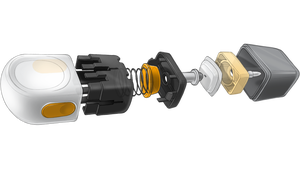May 1, 1997
For the past two years, molders of jewel box packaging that has become a standard for the audio compact disk market have been plagued with resin pricing increases for polystyrene that pushed margins to their lowest
ever. One answer to that problem has been to thin out the wall sections of the jewel boxes to get the material content reduced. However, that led to the problem of durability, since the jewel box also serves as a storage case after purchase.
Richard Roth, executive vice president of corporate division sales and marketing for the Queens Group Inc. in Long Island, NY, says that the number one complaint from customers is cracked jewel boxes. "The material we use in the Q-Pack solves that problem," he says referring to the company's newest packaging alternative.
The Q-Pack, introduced to the market late last year, is made from high-impact polystyrene, which provides greater durability while retaining the jewel box design. It uses 35 percent less plastic because it eliminates the inner tray used in most other jewel boxes. International Packaging Corp. in Fort Wayne, IN molds the Q-Pack.
As the advent of digital versatile disks (DVDs) remains on the horizon, packaging issues still loom large for manufacturers. Several new jewel box packages have been introduced over the past year that seek to solve the packaging challenges and implement creativity to an over-crowded, price-sensitive market. |
Anthony Gelardi, president of Gelardi Design & Development in Kennebunkport, ME, says that originally the jewel box had a wall thickness of .063 inch. Now, the typical wall thickness is .047 inch. "It doesn't seem like a lot, but in reality it's a significant difference," he explains. "Jewel box manufacturers are squeezed to the max until there are no margins left, with pricing for jewel boxes below 10 cents. Consequently, it's opened up opportunities for other packaging."
Gelardi was one of eight panel members representing packaging manufacturers that addressed a number of issues at a recent meeting of the International Recording Media Assn.
Thomas R. Parkinson, president of Shape Inc. headquartered in Biddeford, ME, says that his company still has a set of original jewel box molds but shelved that tooling because "the market won't bear a 15-cent jewel box."
Parkinson reinforces that quality continues to be an issue that plagues jewel box manufacturers. Reduction in wall thicknesses on jewel boxes presents a whole new set of problems, such as susceptibility to cracking and jams in the automated equipment that CD replicators use in their process.
Andria McClellan, vice president of sales and marketing for Laserfile International Inc. headquartered in Englewood, NJ, agrees, adding that in addition to automation, shipping is also a "definite concern" for replicators. "We need to create a viable product that doesn't crack and with hinge tabs that don't break," she says.
Parkinson says that it all boils down to the cost of the plastic resin. "We can make a jewel box that doesn't break, but the replicators won't pay the price," he says.
Philip M. Clemens, president of International Packaging Corp. in Fort Wayne, IN, adds: "So, we're stuck with hinges." International Packaging is a custom molder of jewel boxes and proprietary specialized disk packaging, supplying CD packaging products to major disk replication facilities throughout North America.
"Not if you use the Laserfile package," McClellan says. The Laserfile package was developed specifically to address such jewel box packaging issues as durability and ease of use. Laserfile's CD and DVD package holds the disk securely in a concave, polypropylene tray that slides out from the bottom of the clear, crystal styrene container, like a drawer (see photo at right). The polypropylene disk tray has a living hinge, which, when fully extended, angles down and away from the DVD for easy removal.
Complex Tooling Inc. in Boulder, CO built the original molds, and supplies some of Laserfile's demand for molded parts for the CD packaging. In December of last year, Laserfile signed an agreement with International Packaging Corp. to mold its package for use with DVD from a second set of tooling that Laserfile had built in response to demand from the replication industry.
Other innovations in packaging include a new design from Optima Precision, a division of Shape Inc. It announced in January of this year the introduction of a new clear tray for its patented Brilliant Box, which holds two CDs in a case the same thickness of a standard jewel box.
A new clear polystyrene tray has been incorporated into the Brilliant Box at the request of customers and provides greater graphic visual appeal, while keeping the patented hinged-tray design that allows two CDs in the package, according to information released by the company.
"The market demand for the Brilliant Box has increased dramatically over the past year," says Shape's Parkinson. Since the Brilliant Box was introduced in North America in 1993, it has become the industry standard with sales increasing by 25 percent in 1996. Both CD-Audio and CD-ROM markets have embraced the innovative packaging because of the substantial cost savings it represents over the traditional double jewel case.
In spite of the use of some paperboard alternatives as a way to get around the price of polymer raw materials, Laserfile's McClellan says she believes plastic is preferable to consumers.
"Paperboard looks good on the store shelf, but once consumers get the package home, they're not excited about it," she says. "Plastic provides durability with consumer use."
Laserfile's polypropylene tray is an attempt to deal with the fragility issue.
You May Also Like


